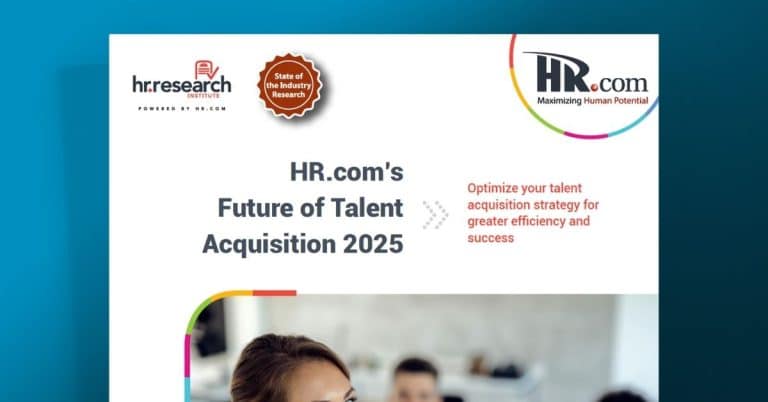
HR.com’s future of talent acquisition 2025
HR.com’s future of talent acquisition 2025
This HR.com research report explores how talent acquisition is evolving in response to rapid changes in business and shifting workforce expectations.
Drawing on responses from over 300 HR professionals, the study identifies how organizations are rethinking strategies, technologies, and metrics to attract and retain top talent this yearand beyond.
In this report, you’ll learn:
- How talent acquisition priorities are shifting to include not just hiring top talent, but also strategic initiatives like workforce planning, skills-based hiring, and internal mobility.
- Why organizations are turning to AI and automation to enhance candidate matching, streamline recruitment, and minimize bias in hiring..
- The talent metrics that matter most right now, as organizations move beyond time to fill to focus on candidate quality, skills alignment, and long-term business impact.
Taken as a whole, talent acquisition strategies continue to advance, yet most organizations still lag behind the state of the art. In fact, about half (51%) still depend on reactive, just-in-time hiring—missing opportunities to plan ahead and recruit top talent. Only 5% rate their TA function as world-class, revealing a major gap between aspiration and execution.
Despite this, talent acquisition remains a key priority for HR, with 46% of organizations ranking it among their top three priorities. Goals such as building a strong talent pipeline (63%) and improving employer branding (55%) are central to these efforts. However, 53% of organizations struggle with a lack of skilled candidates, and 51% continue to face the challenges of reactive hiring. A mismatch between hiring needs and available resources further complicates matters, with only 30% planning to increase their TA budget.
Organizations predominantly rely on a few TA tools, with 73% using applicant tracking systems (ATS) and 70% using job boards. However, AI and predictive analytics are expected to play a transformative role in the coming years, with 58% of organizations anticipating AI’s utility in writing job descriptions and 53% planning to use chatbots for candidate engagement. Despite some interest in new tools, 54% of organizations plan to buy no new TA technologies in the next year.
Our major research findings
- Most organizations rely on reactive hiring, with few achieving world-class talent acquisition.
- Nearly half of organizations rank talent acquisition among their top HR priorities.
- The lack of candidates with the required skills or experience is the top challenge in talent acquisition.
- Despite the availability of a plethora of TA technologies and metrics, organizations primarily rely on a few.
- AI and predictive analytics are set to revolutionize TA capabilities in the next two years.
- Organizations are increasingly adopting multiple TA tools, with a focus on balancing consolidation and new technology adoption.
You might also like...
Get the latest talent news in your inbox every month
By submitting this form, I consent to Eightfold processing my personal data in accordance with its Privacy Notice and agree to receive marketing emails from Eightfold about its products and events. I acknowledge that I can unsubscribe or update my preferences at any time.
